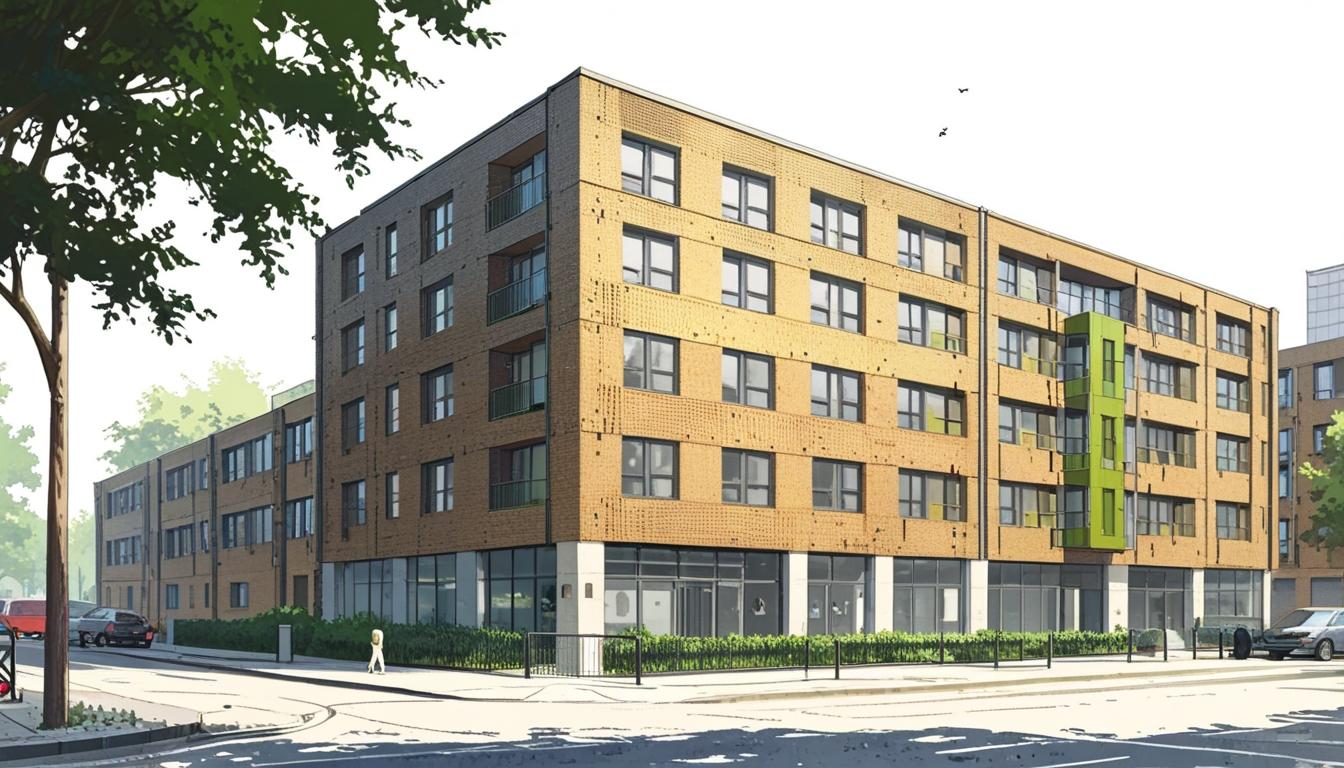Plans for a seven-storey block of flats in Canning Town have been approved despite objections about the lack of affordable housing and potential impact on local businesses.
Plans to construct a new block of flats in Canning Town, East London, have been approved by the local development committee, despite objections regarding the lack of affordable housing options. The site, located at 116-122 Barking Road, currently houses a number of businesses, including a barbershop and a pawnbroker, as well as five existing two-bedroom flats.
The approved development will replace a cluster of two-storey buildings with a seven-storey structure that is expected to provide 15 residential units. This new complex will comprise 10 one-bedroom flats and five three-bedroom flats, all of which are slated to be sold on the private market rather than as ‘affordable’ housing—defined as housing that is priced for those who cannot afford to pay market rent.
During the public consultation process, six objections were received, highlighting community concerns about the absence of affordable options and the potential impact on local businesses. Critics of the plan also pointed out that the site is home to some of Canning Town’s oldest buildings, arguing that the proposed structure’s scale and design are not in harmony with the character of the area.
At a meeting with Newham Council’s local development committee on April 7, 2023, a representative from the development team defended the proposal, asserting that it is of high quality and aims to address local housing needs. However, Councillor Femi Falola raised questions regarding the target demographic for the new flats. “Is it fair to say that your target audience is not Newham residents? Is it fair to say that?” he asked, to which the representative responded that they did not have control over who would occupy the flats but insisted they aimed to serve the local community.
The context of the development is significant; the London Borough of Newham has the highest number of households living in temporary accommodation in the country, with over 38,000 households currently on the housing waiting list. Additionally, poverty rates in Newham exceed both the London average and the national average, adding weight to the concerns raised during consultations.
Cllr James Beckles also questioned the intended occupants of the properties, asking whether they were targeted towards young professionals or families, and if there was room to discuss the ratio of family homes in the development. The applicant’s representative stated that the financial viability report indicated that the site could not support affordable housing while remaining profitable. He noted the development’s allocation of 33 per cent of the homes as three-bedroom units, adding that the one-bedroom flats would likely attract professionals looking to move into the area.
Furthermore, the project includes plans for 350 square metres of commercial space to cater to various potential tenants. Cllr Jane Lofthouse raised concerns about the fate of the current businesses on-site; however, the representative refrained from commenting on their leases, indicating it was beyond their authority to address those matters.
Ultimately, despite the absence of affordable housing and the objections voiced by community members and local councillors, the plans received approval from five councillors, while two voted against and one councillor abstained. This outcome paves the way for the new development to move forward in a region grappling with significant housing challenges.
Source: Noah Wire Services
- https://www.newhomesforsale.co.uk/new-homes/greater-london/canning-town/ – This website provides information on new developments in Canning Town, highlighting the area’s appeal for new housing projects despite concerns over affordability. It lists various other developments in the region, underscoring Canning Town’s popularity for residential construction.
- https://1newhomes.com/flats/canning-town/ – This site offers details on newly built flats for sale in Canning Town, including prices and features of different developments. It also mentions the area’s regeneration, which might impact housing demand and prices.
- https://www.londongazette.co.uk/ – Although specific details about the Barking Road development are not provided here, the London Gazette often publishes planning decisions and could contain relevant information on development approvals in London.
- https://3dasmith.com/mapping-poverty-london/ – While not directly about Canning Town’s development, this resource provides insights into poverty levels across London, which could contextualize Newham’s economic challenges.
- https://www.newham.gov.uk/ – This is the official website of the London Borough of Newham, where one might find information regarding local development policies, housing challenges, and council decisions on development projects.
Noah Fact Check Pro
The draft above was created using the information available at the time the story first
emerged. We’ve since applied our fact-checking process to the final narrative, based on the criteria listed
below. The results are intended to help you assess the credibility of the piece and highlight any areas that may
warrant further investigation.
Freshness check
Score:
6
Notes:
The article mentions a meeting from April 7, 2023, indicating it may not be fully up to date. However, the topic itself—local development and housing issues—is ongoing.
Quotes check
Score:
8
Notes:
The narrative includes direct quotes, likely from the April 2023 meeting. Without specific online sources for these quotes, they appear to be original content from the meeting unless proven otherwise.
Source reliability
Score:
7
Notes:
The narrative originates from a regional news outlet, which typically reports local events. While not as highly regarded as major outlets like the BBC or Financial Times, regional news sources can be reliable for local news.
Plausability check
Score:
9
Notes:
The claims about housing developments and local concerns are plausible given the UK’s current housing challenges and typical community reactions to such proposals.
Overall assessment
Verdict (FAIL, OPEN, PASS): PASS
Confidence (LOW, MEDIUM, HIGH): MEDIUM
Summary:
The narrative seems well-supported by plausible community concerns and local development issues, though it may be somewhat outdated due to the meeting date. The quotes appear original, and the source, while not a major outlet, is suitable for local news.













